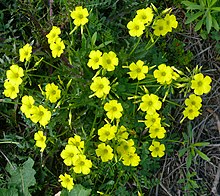Nodding wood sorrel
| Nodding wood sorrel | ||||||||||||
|---|---|---|---|---|---|---|---|---|---|---|---|---|

Nodding wood sorrel ( Oxalis pes-caprae ) |
||||||||||||
| Systematics | ||||||||||||
|
||||||||||||
| Scientific name | ||||||||||||
| Oxalis pes-caprae | ||||||||||||
| L. |
The Nodding sour clover , also Low sorrel ( Oxalis pes-caprae , Syn. : Oxalis cernua Thunb. , Bolboxalis cernua . (Thunb) Small ), is a species of the genus sorrel ( Oxalis ). The Latin epithet pes-caprae means goat's foot and probably refers to the short, bilobed pinnate leaves.
features
The Nodding sour clover is a perennial , herbaceous plant . The plant reaches heights of between 10 and 50 centimeters. The leaf rosette consists of up to 20 centimeters long stalked, trefoil-like, three-part pinnate leaves . The individual leaflets are deeply inverted heart-shaped and hairy on the underside.
There are six to twelve funnel-shaped flowers on the long-stalked, golden inflorescence . The buds are nodding, later the flowers are erect. The hermaphrodite, five-fold flowers have a diameter of about 1.5 centimeters. The five sepals are free. The five 2 to 2.5 centimeters long, lemon-yellow petals are fused at their base. The variety Oxalis pes-caprae var. Pleniflora (Lowe) Sunding, which occurs mainly in the Canary Islands , has double flowers. There are two circles with five stamens each. Five carpels have become a top permanent ovary grown. The flowering period extends from December to May.
Chromosome number: The nodding wood sorrel is diploid with 2n = 14 or polyploid with 2n = 28 or 35. In the Mediterranean area, the nodding wood sorrel is tetraploid (2n = 28) or pentaploid (2n = 35).
Multiplication
The nodding wood sorrel has interesting sexual reproduction. There are three types of flowers:
- Type S: carpel short, stamens medium and long.
- Type M: carpel of medium length, stamens short and long.
- Type L: carpel long, stamens short and medium-long.
A short carpel can only be fertilized by pollen from a short stamen, analogously a medium-length carpel only from medium-length stamens and a long carpel only from long stamens. Self-fertilization is therefore excluded. All three types of flowers occur in South Africa. Therefore, spreading by seeds is possible there. However, only type S was introduced into the Mediterranean region. Therefore, capsule fruits are hardly formed in the Mediterranean area, but rather it spreads vegetatively through nodules that sit on the rhizome . That sexual reproduction does take place in individual cases was shown by Castro et al. examined.
Occurrence
This species is an invasive plant in many parts of the world .
The nodding wood sorrel originally comes from South Africa and was probably introduced there at the beginning of the 19th century by Carlo Giacinto , a Genoese monk and then curator of the Floriana , the botanical gardens on Malta . Within a few decades, the species spread to Malta, then to the rest of the Mediterranean and even along the Atlantic coast of Europe to the south of Devon , where it has since been naturalized. It is also naturalized in the Canary Islands , Azores and Madeira . In Malta, the parasitic summer root Orobanche ramosa subsp. mutelii specializes in the nodding wood sorrel as host. The plant can completely destroy stocks of the nodding wood sorrel in a few weeks.
The species prefers cultivated land as a location, especially among tree cultures. During the heyday, the nodding wood sorrel is a defining part of the landscape in certain areas, for example in Sicily .
literature
- Peter Schönfelder, Ingrid Schönfelder: What is in bloom in the Mediterranean? 750 species (= Kosmos nature guide ). 4th edition. Franckh-Kosmos, Stuttgart 2005, ISBN 3-440-10211-4 .
- Adalbert Hohenester, Walter Welss: Excursion flora for the Canary Islands. With views of the whole of Macaronesia . Eugen Ulmer, Stuttgart (Hohenheim) 1993, ISBN 3-8001-3466-7 ( PDF file; 23.2 MB ).
Individual evidence
- ↑ Helmut Genaust: Etymological dictionary of botanical plant names. 3rd, completely revised and expanded edition. Birkhäuser, Basel / Boston / Berlin 1996, ISBN 3-7643-2390-6 .
- ^ A b J. Costa, V. Ferrero, J. Loureiro, M. Castro, L. Navarro and S. Castro: Sexual reproduction of the pentaploid, short-styled “Oxalis pes-caprae” allows the production of viable offspring. In: Plant Biology. Vol. 16, 2014, pp. 208-214 (PDF).
- ↑ S. Castro, J. Loureiro, C. Santos, M. Ater, G. Ayensa, L. Navarro: Distribution of flower morphs, ploidy level and sexual reproduction of the invasive weed Oxalis pes-caprae in the western area of the Mediterranean region. In: Annals of botany. Volume 99, number 3, March 2007, pp. 507-517, doi : 10.1093 / aob / mcl273 , PMID 17218342 , PMC 2802954 (free full text).
- ^ Hans Christian Weber, Bernd Kendzior: Flora of the Maltese Islands - A Field Guide. Weikersheim 2006, ISBN 3-8236-1478-9 , p. 248.
- ^ PJ Schembri, E. Lanfranco: Introduced species in the Maltese Islands. In: AE Baldacchino, A. Pizzuto (Ed.): Introduction of alien species of flora and fauna. [Proceedings of a seminar in Qawra, Malta, March 5, 1996], Environment Protection Department, Floriana (Malta) 1996, pp. 29-54.
Web links
- Profile from Michael Becker
- Comprehensive description with photos at The Nature Conservancy
- Nodding wood sorrel with double petals in the Flora Vascular de Canarias (Spanish)


